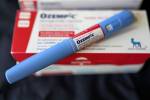Avoiding food-borne illness
By KRISTI EATON
VIEW ON HEALTH
Right on the heels of news that an E. coli outbreak in Europe has killed at least 30 people, sickened at least 3,000 others and left hundreds with complications -- including Americans -- the Centers for Disease Control and Prevention has released a new report that says roughly one of every six Americans gets sick each year from eating contaminated food.
The report focuses mainly on Salmonella, which causes more hospitalizations and deaths than any other type of germ found in food. Each year, 1 million people get sick from eating food contaminated with Salmonella, resulting in $365 million in direct medical costs, the report stated.
The report shows that while there has been a drop in E. coli 0157 over the past 15 years, Salmonella cases continue at a steady pace.
"We know that reducing contamination works," the report stated. "During the past 15 years, a dangerous type of E. coli infection, responsible for the recall of millions of pounds of ground beef, has been cut almost in half. Yet during that same time, Salmonella infection, which causes more hospitalizations and deaths than any other type of germ found in food and $365 million in direct medical costs annually, has not declined."
CDC REPORT ON SALMONELLA
About 48 million get sick each year from contaminated food in the United States, according to the CDC report, "Making Food Safer To Eat."
While E. coli 0157 infections have nearly been cut in half since 1997, the report said reducing the number of Salmonella infections remains a problem for many reasons:
* It is found in many different types of foods, including meats, eggs, fruits, vegetables and processed foods like peanut butter
* Contamination can occur at any point in the food-development process, from the crops to the kitchen where it is cut up
* The way Americans eat has changed over the years. Food no longer comes from a central location and is instead distributed widely, so sickness is able to spread faster and affect more people
The report said that poultry is the leading food associated with Salmonella outbreaks. It's responsible for 29 percent of outbreak cases. Following poultry is the "other" category that includes sprouts, leafy greens, roots, fish, grains-beans, shellfish, oil-sugar and dairy. The "other" category makes up 20 percent of cases. After that, eggs are the next leading cause, with 18 percent of outbreaks associated with them. Vine vegetables, fruits and nuts (13 percent), pork (12 percent) and beef (8 percent) round out the causes for the infections.
The report said inspections in the United States and abroad should increase and be improved. The government should also develop safety standards for fruits and vegetables, and learn from the past.
"Use what is learned from outbreaks, inspections, and monitoring systems to develop new and improve existing prevention strategies," the report recommended.
The report encouraged farmers, grocery stores and sellers to use good management practices to reduce contamination when raising livestock and to follow U.S. Food and Drug Administration Model Food Code in restaurants and other places that serve food while health care providers should target high-risk populations and inform them about food safety.
It said everyone can reduce the risk by washing hands, separating raw meat, poultry and seafood from other foods, making sure foods are cooked thoroughly or chilled, and refraining from preparing food if vomiting or experiencing diarrhea.
"Be especially careful preparing food for children, pregnant women, those in poor health, and older adults," the CDC report said.
THE RECENT OUTBREAK
Officials recently determined that the cause of the German outbreak in early May was German-grown bean and seed sprouts.
The World Health Organization said the outbreak is centered primarily in Germany and an investigation continued for more than a month into the cause of the unusual outbreak.
Texas Tech University food safety expert Guy Loneragan said the outbreak of _E. coli_ O104:H4 centered in northern Germany is a strain observed very rarely in the past. It's a close cousin to the more well-known E. coli O157:H7.
"People typically become infected with these types of bacteria, called Shiga-toxin producing E. coli (or STEC), through food and sometimes are part of a food-borne outbreak. It is assumed that in the current outbreak, people were infected via food," he said.
There are many different types of bacteria and some are pathogenic, Loneragan said. In the case of E. coli, the minotiry that is pathogenic can be broken down into subsets. E. coli O157 is classified as a shiga-toxin producing E. coli, or STEC. Other types that can cause disease include Enteroaggregative E. coli, or EAEC, and Enteropathogenic E. coli, EPEC.
"(This) is important in the current case. E. coli O157 is a STEC and their normal host is usually a ruminant animal like cattle but can also be goats, sheep, bison, elk," Loneragan said. "The E. coli O104:H4 of the current outbreak produces Shiga toxin so it was called a STEC -- a type of bacteria we are familiar with."
But, he added, scientists found that the current E. coli O104:H4, more closely resembled an EAEC.
"This is important because the usual reservoir for STECs are ruminants but the usual reservoir for EAECs are humans."
The Centers for Disease Control says that although rare, E. coli O104:H4, the strain involved in the current outbreak, has been identified before. In 2009, two patients in the Republic of Georgia had a strain similar to the current outbreak.
"That strain produced Shiga toxin, but had a different molecular fingerprint and was less resistant to antibiotics than the current outbreak strain in Germany," the CDC stated in a release. "No clear outbreak was identified in the Republic of Georgia, and no food was identified as a source of infections."
As of June 9, the World Health Organization says Germany has reported 759 cases of hemolytic uremic syndrome, or HUS, a serious kidney complication associated with E. coli infections. Of those 759, 21 people have died. Thirteen other European countries have reported a total of 35 HUS cases, including one that was fatal.
"There are several patients outside of Germany who have been affected, including some patients in the U.S., but almost all recently traveled to northern Germany and were likely infected there," Loneragan said.
The Associated Press reported that another E. coli strain, apparently less dangerous, has been found in the Netherlands. Dutch authorities have recalled beets in three countries in an effort to contain and find the cause of the strain.
Loneragan said the size of an E. coli outbreak is largely dependent on what food is contaminated -- say, salad or beef, the environmental source, the number of people affected and the pathology of the bacteria.
"In the case in Germany, the pathogen appears to have been widely disseminated in a food -- likely something to do with salad products and it appears the likely culprit is sprouts -- and the bacterium is unusually pathogenic," he said. "Obviously we need the investigations to continue to identify the source and point of contamination and situations that allowed that contamination so that we can assess what lessons are to be learned from this outbreak."
WHAT YOU SHOULD KNOW
Research shows that E. coli can survive for days or even weeks on hard surfaces like counter tops or in refrigerators, said Donald Schaffner, director of the Center for Advanced Food Technology at Rutgers University.
Most forms of E. coli are not disease-causing bacteria, he said.
"You can eat as many as you want and they won't make you sick," Schaffner said. "Theoretically, ingesting a single cell of pathogenic E. coli can make you sick, but it's like a lottery."
He said one recent report estimates the risk at about 3 percent when a single cell is ingested.
"So for every 30 people eating one cell, 1 will get sick," he said, adding that the risk may be higher for children. "Of course, the more cells you ingest the higher your risk -- like buying more lottery tickets -- such that 100 cells means a 10 percent chance of illness, and 1000 cells almost a 100 percent chance of illness."
Cross contamination can occur from the juices of raw meats or from hands that have been contaminated with fecal matter.
"Sponges and dirty dish towels can also be a source of cross-contamination," he added.
According to the CDC, symptoms of someone with the infection include severe stomach cramps, diarrhea that is often bloody and vomiting. If a fever is present, it is often very high.
Most people affected by the infection usually get better within five to seven days, but for those who don't, they may start to develop HUS. HUS usually develops about a week after the start of the diarrhea and the symptoms include decreased frequency of urination, fatigue and fading skin color because of anemia.
The initial symptom of the Shiga-toxin producing E. coli is diarrhea, and most cases are resolved, Loneragan said, adding that the important thing to do is stay hydrated.
"In the current outbreak, the bacterium appears particularly pathogenic," he said. "About 20 to 30 percent of cases with diarrhea -- severe enough to see a doctor -- have developed HUS, most cases are adult women, and the case fatality rate is greater than 1 percent. This is a particularly virulent bacterium and regardless of whether or not it is an EAEC with Shiga toxins or an STEC with some SAEC genes, it is a serious infection."
The yearly incidence rate for E. coli O157 in the United States is about 1 out of 100,000 people, Lonergan said. "So for s city like Las Vegas, there might be on average 5 to 6 total cases a year," he said, "so it is certainly not a common event."
Although the United States is certainly accustomed to E. coli O157, other countries see it more frequently. Lonergan said Argentina, which relies on a grass-based cattle production system, has an incidence rate that is about 15 fold greater than the United States. And several northern European countries have an incidence rate almost double that of America.
WHAT YOU CAN DO
Schaffner said people in the United States do not need to be concerned about becoming part of the outbreak because most of the produce consumed in America is grown locally, in Mexico or in South America.
"While the definitive source of the outbreak is not known yet -- cucumbers from Spain were originally implicated, but the source now seems to be German sprouts, it seems very unlikely that any of the contaminated produce has made it to the U.S.," he said prior to German authorities announcing that sprouts were the definitive cause.
If traveling abroad, people should check for CDC travel notices on the agency's website, Schaffner said.
More than anything, common sense is key -- whether traveling abroad this summer or remaining at home, he said.
This includes making sure pre-made salads and cut fruits and vegetables are kept at proper temperatures -- 40 degrees Fahrenheit or 4 degrees Celsius, not eating wilted or damaged-looking produce and knowing that eating sprouts may be risky.
"Most important," Schaffner said, "speak up and ask questions at a restaurant if you have concerns or something doesn't seem right."
And, he added, the recent outbreak should not scare people away from eating fruits and vegetables.
"It's important that fruits and vegetables remain a part of a healthy diet, and we should not use this outbreak as an excuse avoid eating fruits and vegetables," Schaffner said.





















